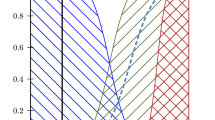Abstract
Autonomy is a fundamental property for an intelligent virtual agent. The problem in the design of an autonomous IVA is that the respective models approach the interactive, environmental and representational aspects of the agent as separate to each other, while the situation in biological agents is quite different. A theoretical framework indicating the fundamental properties and characteristics of an autonomous biological agent is briefly presented and the interactivist model of representations combined with the concept of a semiotic process are used as a way to provide a detailed architecture of an autonomous agent and its fundamental characteristics. A part of the architecture is implemented as a case study and the results are critically discussed showing that such architecture may provide grounded representational structures, while issues of scaling are more difficult to be tackled.
Preview
Unable to display preview. Download preview PDF.
Similar content being viewed by others
References
Aylett, R., Luck, M.: Applying Artificial Intelligence to Virtual Reality: Intelligent Virtual Environments. Applied Artificial Intelligence 14(1), 3–32 (1999)
Thalmann, D.: Control and Autonomy for Intelligent Virtual Agent Behaviour. In: Vouros, G.A., Panayiotopoulos, T. (eds.) SETN 2004. LNCS (LNAI), vol. 3025, pp. 515–524. Springer, Heidelberg (2004)
Gillies, M., Ballin, D.: Integrating Autonomous Behavior and User Control for Believable Agents. In: 3rd International Joint Conference on Autonomous Agents and Multi Agent Systems (AAMAS 2004), pp. 336–343 (2005)
Dinerstein, J., Egbert, P.K.: Fast multi-level adaptation for interactive autonomous characters. ACM Transactions on Graphics 24(2), 262–288 (2005)
Gratch, J., Rickel, J., Andre, E., Badler, N., Cassell, J., Petajan, E.: Creating interactive virtual humans: Some assembly required. IEEE Intelligent Systems 17(4), 54–63 (2002)
Kasap, Z., Magnenat-Thalmann, N.: Intelligent Virtual Humans with Autonomy and Personality: State-of-the-Art. Intelligent Decision Technologies 1(1-2), 3–15 (2007)
Harnad, S.: The Symbol Grounding Problem. Physica D 42, 335–346 (1990)
Janlert, L.E.: Modeling change: The frame problem. In: Pylyshynn, Z.W. (ed.) The robots dilemma: The frame problem in artificial intelligence. Ablex, Norwood (1987)
Rickel, J., Johnson, W.L.: Animated Agents for Procedural Training in Virtual Reality: Perception, Cognition, and Motor Control. Applied Artificial Intelligence 13, 343–382 (1999)
Ziemke, T.: Rethinking Grounding. In: Riegler, P., von Stein (eds.) Understanding Representation in the Cognitive Sciences. Plenum Press, New York (1999)
Arnellos, A., Spyrou, T., Darzentas, J.: Towards the Naturalization of Agency based on an Interactivist Account of Autonomy. New Ideas in Psychology (Forthcoming, 2008)
Collier, J.: Autonomy in Anticipatory Systems: Significance for Functionality, Intentionality and Meaning. In: Dubois, D.M. (ed.) The 2nd Int. Conf. on Computing Anticipatory Systems. Springer, New York (1999)
Arnellos, A. Spyrou, T., Darzentas, J.: Emergence and Downward Causation in Contemporary Artificial Agents: Implications for their Autonomy and Some Design Guidelines. Cybernetics and Human Knowing (Forthcoming, 2008)
Ruiz-Mirazo, K., Moreno, A.: Basic Autonomy as a Fundamental Step in the Synthesis of Life. Artificial Life 10, 235–259 (2004)
Bickhard, M.H.: Representational Content in Humans and Machines. Journal of Experimental and Theoretical Artificial Intelligence 5, 285–333 (1993)
Bickhard, M.H.: Autonomy, Function, and Representation. Communication and Cognition — Artificial Intelligence 17(3-4), 111–131 (2000)
Peirce, C.S.: The Essential Peirce. Selected Philosophical Writings, vol. 1(1867–1893). Indiana University Press, Bloomington, Indianapolis (1998)
Arnellos, A., Spyrou, T., Darzentas, J.: Dynamic Interactions in Artificial Environments: Causal and Non-Causal Aspects for the Emergence of Meaning. Systemics, Cybernetics and Informatics 3, 82–89 (2006)
Tani, J., Nolfi, S.: Learning to perceive the world as articulated: An approach for hierarchical learning in sensory-motor systems. In: Proceedings of the fifth international conference on simulation of adaptive behavior. MIT Press, Cambridge (1998)
Vogt, P.: The emergence of compositional structures in perceptually grounded language games. Artificial Intelligence 167(1-2), 206–242 (2005)
Roy, D.: Semiotic Schemas: A Framework for Grounding Language in the Action and Perception. Artificial Intelligence 167(1-2), 170–205 (2005)
Author information
Authors and Affiliations
Editor information
Rights and permissions
Copyright information
© 2008 Springer-Verlag Berlin Heidelberg
About this paper
Cite this paper
Arnellos, A., Vosinakis, S., Anastasakis, G., Darzentas, J. (2008). Autonomy in Virtual Agents: Integrating Perception and Action on Functionally Grounded Representations. In: Darzentas, J., Vouros, G.A., Vosinakis, S., Arnellos, A. (eds) Artificial Intelligence: Theories, Models and Applications. SETN 2008. Lecture Notes in Computer Science(), vol 5138. Springer, Berlin, Heidelberg. https://doi.org/10.1007/978-3-540-87881-0_6
Download citation
DOI: https://doi.org/10.1007/978-3-540-87881-0_6
Publisher Name: Springer, Berlin, Heidelberg
Print ISBN: 978-3-540-87880-3
Online ISBN: 978-3-540-87881-0
eBook Packages: Computer ScienceComputer Science (R0)




